人教版PEP四年级下册英语《第四单元Unit4》教学设计公开课教案
人教PEP版四年级英语下册Unit4单元教案
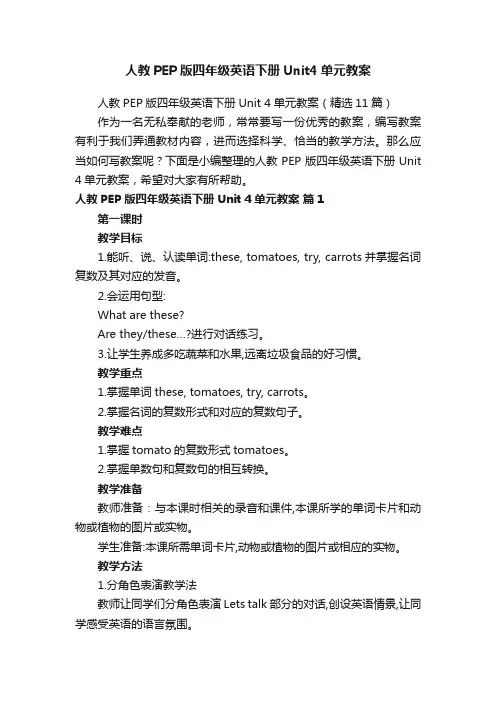
人教PEP版四年级英语下册Unit4单元教案人教PEP版四年级英语下册Unit 4单元教案(精选11篇)作为一名无私奉献的老师,常常要写一份优秀的教案,编写教案有利于我们弄通教材内容,进而选择科学、恰当的教学方法。
那么应当如何写教案呢?下面是小编整理的人教PEP版四年级英语下册Unit 4单元教案,希望对大家有所帮助。
人教PEP版四年级英语下册Unit 4单元教案篇1第一课时教学目标1.能听、说、认读单词:these, tomatoes, try, carrots并掌握名词复数及其对应的发音。
2.会运用句型:What are these?Are they/these…?进行对话练习。
3.让学生养成多吃蔬菜和水果,远离垃圾食品的好习惯。
教学重点1.掌握单词these, tomatoes, try, carrots。
2.掌握名词的复数形式和对应的复数句子。
教学难点1.掌握tomato的复数形式tomatoes。
2.掌握单数句和复数句的相互转换。
教学准备教师准备:与本课时相关的录音和课件,本课所学的单词卡片和动物或植物的图片或实物。
学生准备:本课所需单词卡片,动物或植物的图片或相应的实物。
教学方法1.分角色表演教学法教师让同学们分角色表演Lets talk部分的对话,创设英语情景,让同学感受英语的语言氛围。
2.游戏教学法学生三人一组,进行对话:What are these?Are these apples?Are these tomatoes? Yes.在对话过程中不断增强学生的学习兴趣。
教学过程Step 1: Warm-up1.教师热情地和学生打招呼问好,做简单的Free talk。
2.播放歌曲Mary has a little lamb。
3.看图片拼读单词教师展示图片(已经学过的动物名词),说:Whats this in English?Its a/an… How do you spell it?让学生一个接一个地快速说出对应的单词及其拼写。
【PEP】四年级下英语Unit 4优质课教学设计
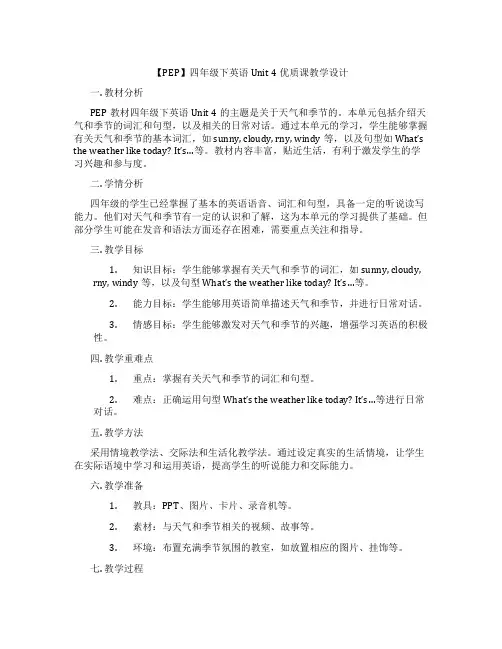
【PEP】四年级下英语Unit 4优质课教学设计一. 教材分析PEP教材四年级下英语Unit 4的主题是关于天气和季节的。
本单元包括介绍天气和季节的词汇和句型,以及相关的日常对话。
通过本单元的学习,学生能够掌握有关天气和季节的基本词汇,如sunny, cloudy, rny, windy等,以及句型如What’s the weather like today? It’s…等。
教材内容丰富,贴近生活,有利于激发学生的学习兴趣和参与度。
二. 学情分析四年级的学生已经掌握了基本的英语语音、词汇和句型,具备一定的听说读写能力。
他们对天气和季节有一定的认识和了解,这为本单元的学习提供了基础。
但部分学生可能在发音和语法方面还存在困难,需要重点关注和指导。
三. 教学目标1.知识目标:学生能够掌握有关天气和季节的词汇,如sunny, cloudy,rny, windy等,以及句型What’s the weather like today? It’s…等。
2.能力目标:学生能够用英语简单描述天气和季节,并进行日常对话。
3.情感目标:学生能够激发对天气和季节的兴趣,增强学习英语的积极性。
四. 教学重难点1.重点:掌握有关天气和季节的词汇和句型。
2.难点:正确运用句型What’s the weather like today? It’s…等进行日常对话。
五. 教学方法采用情境教学法、交际法和生活化教学法。
通过设定真实的生活情境,让学生在实际语境中学习和运用英语,提高学生的听说能力和交际能力。
六. 教学准备1.教具:PPT、图片、卡片、录音机等。
2.素材:与天气和季节相关的视频、故事等。
3.环境:布置充满季节氛围的教室,如放置相应的图片、挂饰等。
七. 教学过程1.导入(5分钟)利用图片和实物展示不同的天气和季节,引导学生用中文进行描述。
然后提问:“你们知道英语中如何描述天气和季节吗?”引出本课主题。
2.呈现(10分钟)展示PPT,呈现本课的生词和句型。
四年级下册英语 unit4教案 人教pep

人教PEP四年级英语下册教案unit4 it is warm todayA.read & write教学目标:1.掌握本课新单词;2.掌握本课关于天气方面的表达句式及关于足球运动方面词汇及句式;3.掌握本课词组。
教学重点:掌握关于天气方面的表达方式。
教学难点:新词汇及句型。
教学工具:课件,单词卡片等等。
教学过程:Warm-up:Let’s chant (page 47)Preview:看图回答: Look at the pictures. What’s the we ather like?It’s hot/ cold/ warm/ cool.Set up a situation:1. 出示东莞天气图:T: What’s the weather like in Dong Guan today?Ss: It’s warm today.Yes. It’s warm today. Let’s play football. (show a football) Now, let’s have 2 teams, team1 and team2. Let’s have a match. (Learn to say: It’s warm today. Let’s play football.)板书It’s warm today. Let’s play football.2.T: Where do you play football? Let’s go to the playground.3. T: Look. My friends are on the playground, too. Who are they?Tommy, Teddy, Jacky and Johnny. Let’s play together. Presentation:1.T: Zoom is not here. Where is he?(播放zoom在房间找东西的video)Oh. He is in his room. He can’t find his shoes.Let’s read the dialogue and tick or cross.(in 2 mi ns)It’s cold today.( )Zoom and Johnny go to play football.( )Johnny wears Zoom’s shoes. ( )Check the answer:2.watch the video:Oh, Johnny made a mistake. He wears Zoom’s shoes.3.Listen and repeat:Zoom 看到自己的鞋子的时候Johnny问:Where are they?Zoom回答:Th ey’re on your feet.(先请同学回答)难点解决:T: Where are my shoes?S1: They’re on your feet.T: Yes. They’re on my feet. Where are your shoes?S1: They’re on my feet.4.T带读5.pair work:6.分组角色表演(in 2 mins)7.act out the dialogue(设置好情境,戴头饰)Practice:1.T: Look at Zoom’s ro om. There are many clothes on the floor. What are they?jeans/ pants/ socks/ shoes.Let’s chant: Jeans, jeans, Johnny’s jeans.Pants, pants, Tommy’s pants.Socks, socks, Ted dy’s socks.Shoes, shoes, where are Zoom’ shoes?3. complete the words: _eansspell the words (板书单词)4.现在用2分钟时间来记住这些单词,等下我们来玩一个游戏,看谁记得又快又好.5.Spelling game:Look at the boxes. What’s in it? Can you g uess?6.Spell all the words and the sentences: 跟住书空7.Your spelling is good. How about your writing?Copy the words and sentences on your activity books.(in 2 mins) 看哪组代表写的好(让学生来读,然后评价)4.Let’s write(in 2 mins)Fill in the blanks: What’s missing in the dialog ue?Zoom: What’s the weather like today?Johnny: ______________________.Zoom: _______________________.Johnny: Great!Zoom: Johnny’s j_____, Tommy’s p______, Teddy’s s_______. Where are my s________?Johnny: Sorry, Zoom. Your ________ are on my feet.Check the answer:请同学拿上来投影,读一读,并检查其书写看看老师的答案(呈现答案)Let’s read together.Sum-up:Zoom has found his shoes now. Let’s play football together. Sing a song: It’s warm. It’s warm. It’s warm today.Put on your shoes, go out to play.Go to the playground, play football.It’s a warm day today.Sports are good. Let’s do more sports.Homework:1.write the words and sentences for 2 lines.。
【PEP】四年级下英语Unit 4优质精品课教学设计
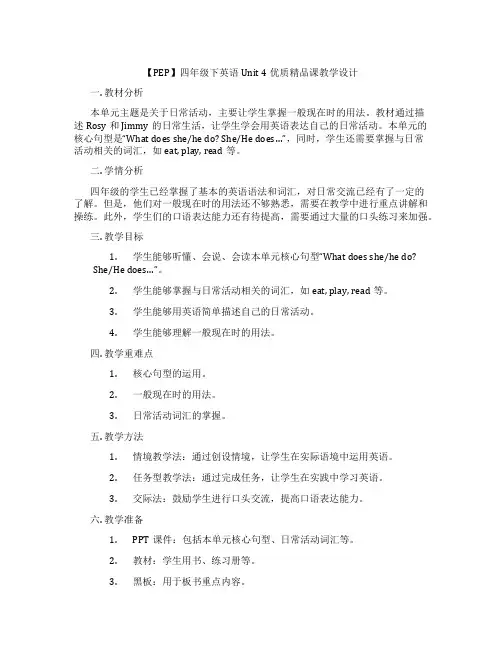
【PEP】四年级下英语Unit 4优质精品课教学设计一. 教材分析本单元主题是关于日常活动,主要让学生掌握一般现在时的用法。
教材通过描述Rosy和Jimmy的日常生活,让学生学会用英语表达自己的日常活动。
本单元的核心句型是“What does she/he do? She/He does…”,同时,学生还需要掌握与日常活动相关的词汇,如eat, play, read等。
二. 学情分析四年级的学生已经掌握了基本的英语语法和词汇,对日常交流已经有了一定的了解。
但是,他们对一般现在时的用法还不够熟悉,需要在教学中进行重点讲解和操练。
此外,学生们的口语表达能力还有待提高,需要通过大量的口头练习来加强。
三. 教学目标1.学生能够听懂、会说、会读本单元核心句型“What does she/he do?She/He does…”。
2.学生能够掌握与日常活动相关的词汇,如eat, play, read等。
3.学生能够用英语简单描述自己的日常活动。
4.学生能够理解一般现在时的用法。
四. 教学重难点1.核心句型的运用。
2.一般现在时的用法。
3.日常活动词汇的掌握。
五. 教学方法1.情境教学法:通过创设情境,让学生在实际语境中运用英语。
2.任务型教学法:通过完成任务,让学生在实践中学习英语。
3.交际法:鼓励学生进行口头交流,提高口语表达能力。
六. 教学准备1.PPT课件:包括本单元核心句型、日常活动词汇等。
2.教材:学生用书、练习册等。
3.黑板:用于板书重点内容。
4.教学挂图:用于辅助教学。
七. 教学过程1.导入(5分钟)利用课件展示Rosy和Jimmy的日常生活图片,引导学生谈论他们的日常活动。
2.呈现(10分钟)用PPT展示本单元核心句型“What does she/he do? She/He does…”,并用挂图辅助教学。
讲解一般现在时的用法,让学生理解并掌握。
3.操练(10分钟)分组进行角色扮演,让学生模拟对话,练习核心句型。
PEP人教版小学四年级下册 Unit4电子教案
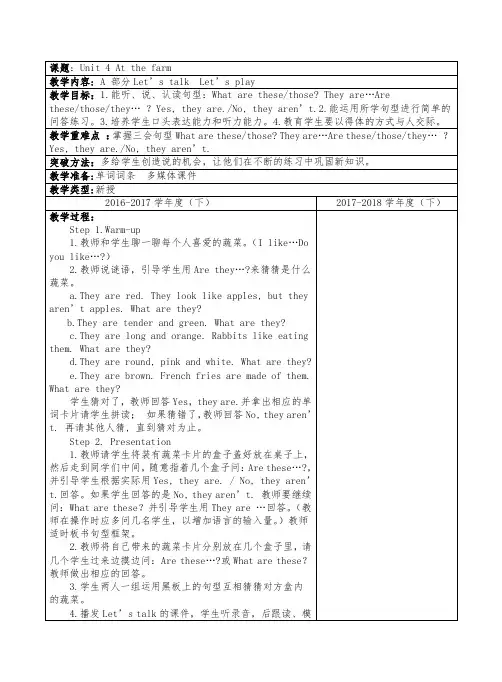
突破方法:1.通过拆音法和拼音法,听音找规律等方式引导学生总结发音规律。2.通过有节奏的大声朗读练习,让学生运用发音规律拼读新单词。
教学准备:多媒体课件 单词词条
教学Байду номын сангаас型:新授
2016-2017学年度(下)
2017-2018学年度(下)
b.Theyare tender and green. What are they?
c.Theyare long and orange. Rabbits like eating them. What are they?
d.Theyare round, pink and white. What are they?
教学类型:新授
2016-2017学年度(下)
2017-2018学年度(下)
教学过程:
Step 1.Warm-up
请学生欣赏Let’s chant部分歌谣,教师要根据歌词适时举起相应的图片。
Step 2. Presentation
1.教师手举一个西红柿,说:I like tomatoes. Do you like tomatoes?引导学生用I like …或I don’t like…根据自己的实际情况表达。
1.播放Read, listen and chant的录音,让学生听歌谣。
2.让学生跟着动画学说歌谣,同时可用手打节奏。
3.播放Read, listen and number 的录音,让学生给单词排序。
4.听音后反复读四个单词,在此基础上进行描红,达到书写格式正确的目的。
Step3. Practice
2.教师再拿起一夹青豆,边说边完全呈现:Oh,it’s long and green. They are green beans. Do you like green beans? 让学生在回答中学习单词。
人教版英语四年级下册的第四单元 Unit 4 At the farm教案
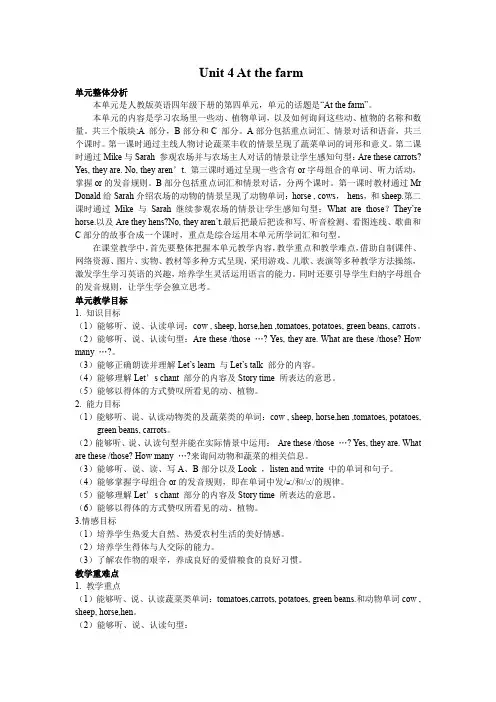
Unit 4 At the farm单元整体分析本单元是人教版英语四年级下册的第四单元,单元的话题是“At the farm”。
本单元的内容是学习农场里一些动、植物单词,以及如何询问这些动、植物的名称和数量。
共三个版块:A 部分,B部分和C 部分。
A部分包括重点词汇、情景对话和语音,共三个课时。
第一课时通过主线人物讨论蔬菜丰收的情景呈现了蔬菜单词的词形和意义。
第二课时通过Mike与Sarah 参观农场并与农场主人对话的情景让学生感知句型:Are these carrots? Yes, they are. No, they aren’t. 第三课时通过呈现一些含有or字母组合的单词、听力活动,掌握or的发音规则。
B部分包括重点词汇和情景对话,分两个课时。
第一课时教材通过Mr Donald给Sarah介绍农场的动物的情景呈现了动物单词:horse , cows,hens,和sheep.第二课时通过Mike 与Sarah 继续参观农场的情景让学生感知句型:What are those?They’re horse.以及Are they hens?No, they aren’t.最后把最后把读和写、听音检测、看图连线、歌曲和C部分的故事合成一个课时,重点是综合运用本单元所学词汇和句型。
在课堂教学中,首先要整体把握本单元教学内容,教学重点和教学难点,借助自制课件、网络资源、图片、实物、教材等多种方式呈现,采用游戏、儿歌、表演等多种教学方法操练,激发学生学习英语的兴趣,培养学生灵活运用语言的能力。
同时还要引导学生归纳字母组合的发音规则,让学生学会独立思考。
单元教学目标1. 知识目标(1)能够听、说、认读单词:cow , sheep, horse,hen ,tomatoes, potatoes, green beans, carrots。
(2)能够听、说、认读句型:Are these /those …? Yes, they are. What are these /those? How many …?。
(人教PEP)四年级英语下册:unit4全英教案
Unit 4单元教材分析Teaching Contents:Unit4 It’s warm todayTeaching Aims:1. Learn to describe the weather.2.Learn to know the key words in listening, speaking, readingand writing.3.Learn to know and understand the sentences of Let’s learn,Read and write & Let’s talk.4.Learn to understand the sentences of Let’s do & Let’schant.5.Learn to understand the story time and Good to know. Ability Aims:Have the students know about the weather of different cities. Emotional Aims:Push the students join the social activity.Teaching Difficult Points:Four skill wordsUse the sentencesTeaching Aids:Pictures, Cards, Tape.The 8th week and 1st planUnit 4 It’s warm todayThe 1st periodTeaching contents:Part A: Let’s learnLet’ playTeaching Aims:1. To act quickly after listening to the T.2. Master the sentences: This is my home. You can see a bedroom...3. New words: study bathroom bedroom living room kitchen Ability Aims:Have the students know about the weather of different cities. Emotional Aims:Push the students join the social activity.Important points and difficult points:1.Learn to understand the key words in listening, speaking andreading.2.Try to understand the word, and use them into sentences.3.Learn to understand the sentences of What’s the weather likein…? It’s …Teaching Aids:A tape-recorder,an English book, a Chinese book,a storybook, a notebook and a math book.Teaching Procedures:Step 1: Warm-up:1.Greetings: How are you?2.Date ,day& weather.What’s the date today?What’s the weather like today? What day is it today?T:what do you wear in hot day/cool day/cold day?S: I can wear skirt/sweater/Step 2: Revision1.The teacher asks the class:What’s your favorite clothes?What colour is your…?Pay attention to the wor d “favorite”2. A game: Guess what colour of the clothes?Step 3: PresentationLet’s learn1.The teacher will show the cards to the class one by one: cool,cold, hot, warm.2.Try to use the new words to make some sentences such as:What’s the weather like…? It’s cool/ cold / hot/ warm.Teacher can give the pictures and let the pupils talk about the weather.3.Listen to the tape, and repeat it after the tape:Good morning. This is the weather report. It’s cool in Lhasa.4.Group work: Watch the VCD first, and then practice thesentences with their group.What’s the weather like in Shanghai/Beijing…?---It’s…Step 4: Practice1.Read the passage ater the tape.2. Read the passage and translate it.3. Read the passage by groups.4. Let’s playHave the students act like the weather reporter.He/She point to the place, others have to say the weather out. Step 5: Homework:1. To copy the new words one line for each2. Ready for a weather report.Board-writing:Unit 4 It’s warm today!weather, cool, cold, hot, warm.What’s the weather like in…?I t’s …ReflectionThe 2nd periodTeaching contents:Let’s talkLet’s chantTeaching Aims:1.Learn to understand the sentences of Let’s talk.2.Learn to express the weather.3.Learn to know the “Can I wear…?” ask and answer.Ability Aims:Have the students know about the weather of different cities. Emotional Aims:Push the students join the social activity.Important points and difficult points:New words and sentencesTeaching Aids:Computer, cassette, cassette recorder, flash cards, some objects.Teaching Procedures:Step 1: Warm-up1.Let’s chantMmm! It’s warm today.Take off your jacket!Phew! It’s hot today!Put on your T-shirt.Ooooh! It’s cool today!Put on your sweater!Brrr! It’s cold today!Put on your coat!Step 2: Revision:1. To review the weather repor t: This is the weather report…. It’s …. And so on.2. To review the main words about weather Further understand the pronunciation of the main words. Especially the words: weather, wear, today, can’t, put on.Step 3: Presentation1.The teacher will point to a picture and say: Is it cool today?They will answer: Yes, it is. / No, it isn’t.2.Let the class practice in pairs: Is it hot …? Yes, it is./ No, it isn’t.3.The teacher points to the picture and asks:W hat’s the weather like…? It’s ….Can I w ear…? Yes, you can. / No, you can’t.Then the teacher asks the questions one by one till all the students understand.4.Let the class make sentences with the structure: It’…today.Can I wear…?Yes, you can. / No, you can’t.5.To watch the VCD, then the teacher will ask some questionsaccording to the dialogue.6.To practice the dialogue in groups/pairs, then act out thedialogue.Step 4: Practice1.Read the dialogue ater the tape.2. Read the dialogue and translate it.3. Read the dialogue by groups.4. Try to make a new dialogue.Step 5: Homework1.To copy the main words each one line.2.To read the dialogue aloud.Board-writing:Unit 4 It’s warm today!Can I wear … ?Yes, you can. / No, you can’tIt’s warm/hot/cool/cold today.Reflection:The 3rd periodTeaching contents:Part B: Let’s learnLet’s doTeaching Aims:1. Learn to know the key words in listening, speaking and reading.2. Learn to figure out the words:rainy, windy, sunny, cloudy, snowy.3. Try to describe the weather: Here’s the world weather. It’s… in….Ability Aims:Have the students know about the weather of different cities. Emotional Aims:Push the students join the social activity.Important points and difficult points:New words and sentencesTeaching Aids:VCD, computer, a chart, cassette and the recorder, wall pictures, flash cards.Teaching procedures:Step 1: Warm-up.1. Greetings: Ask some of them to greet or ask some questions.2.Date & weather report.3.A songStep 2: RevisionReview the sentences below:What’s the weather like today?It’s hot/ warm / cold/ coolStep 3: PresentationLet’s learn1.The teacher will show the cards to the class one by one: rainy,snowy, windy, sunny, cloudy2.Try to use the new words to make some sentences such as:What’s the weather like…? It’s rainy/ snowy/ windy/ sunny/ cloudy3.Listen to the tape, and repeat it after the tape: Here’sthe world weather. It’s rainy in London. ”4.Let them make the sentences with “Here’s the world weather.It’s … in…. ”5.Ask and Answer:What’s the weather like in London? It’s rainy.What’s the weather like in Moscow? It’s snowy. What’s the weather like in Beijing? It’s windy. What’s the weather like in Singapore? It’s sunny. What’s the weather like in Sydney? It’s cloudy. Step 4: Practice1.Read the new words one by one.2.Let’s doPractice the sentences in groups:It’s rainy. Open up your umbrella.It’s windy. Hold on to your hat.It’s sunny. Put on your sunglasses.It’s snowy. Put on your boots.Step 5: Homework1.Read the Let’s do aloud.2.Copy the main words and sentences two times each. Board-writing:Unit 4rainy windy sunny cloudy snowyHere’s the world weather. It’s … in…. Reflection:The 4th periodTeaching contents:Let’s talkLet’s find outTeaching Aims:1. Learn to master the four-skilled words about the weather.2. Learn to master the way to write the key words and the sentences.3. Try to understand the meaning of the dialogue.Ability Aims:Have the students know about the weather of different cities. Emotional Aims:Push the students join the social activity.Important points and difficult points:New words and sentencesTeaching Aids:Computer, cassette, cassette recorder, flash cards, some objects.Teaching Procedures:Step 1: Warm-up.1.Greetings: How are you feeling today?2.Day, date & weathe r: What’s the date?What’s the weather like outside? It’s….Step 2: RevisionReview the key words and sentences below:Rainy, snowy, windy, sunny, cloudy, hot, cold, warm, cool Step 3: Presentation1.Show Ss a picture. Let them look and think carefully andtry to say some sentences about the picture.2.To watch the VCD, then the teacher will ask some questionsaccording to the dialogue.What are they doing? ---They are talking.What’s the weather like in Beijing? ---It’s rainy.What’s the weather like in New York? ---It’s sunny.What happened in Amy’s house?3.Show some instructions and teaching these sentences:What are you doing? Not much.What’s the weather like in Beijing? It’s rainy.What’s the weather like in New York? It’s sunny.It’s windy now. I have to close the window.4.Watch and listen.Let Ss watch VCD, listen carefully, try to understand the main idea of the dialogue. Explain any difficulties to help them.5. Group work. Read the dialogue aloud in groups.6. Act out. Ask some groups to act out it.Step 4: Practice1.Read the dialogue ater the tape.2. Read the dialogue and translate it.3. Read the dialogue by groups.4. Try to make a new dialogue.5. Do the exercise in “Let’s find out”.Step 5: Homework1. To copy the main words each one line.2. To read the dialogue aloud.Board-writing:Unit 4 It’s warm today!What’s weather like in Beijing/ New York?It’s rainy/ sunny.Reflection:The 5th periodTeaching contents:Part A: Read and whitePart C: Task time/ Pronunciation/Let’s check.Teaching Aims:1.Learn to master the four-skilled words about the colors andclothes.2.Learn to master the way to write the key words and thesentences.3.Try to understand the meaning of the dialogue.4.Copy the sentences.Ability Aims:To train the students’ creativity.Emotional Aims:Cultivate them to co-operate with each other.Important points and difficult points:1.Learn to master the right way to write the key words and thesentences.2.Try to make an own dialogue with the sentences they havelearnt.Teaching Aids:a tape recorder cards picturesTeaching Procedures:Step 1: Warm-up.1. Greetings: How are you feeling today?2. Date & weather: What’s the date?What’s the weather like outside?Step 2: Revision1. Recite a chant:Mmm! It’s warm today. Take off your jacket!Phew! It’s hot today! Put on your T-shirt.Ooooh! It’s cool today! Put on your sweater!Brrr! It’s cold today! Put on your coat!2.Review the free talk by pupils. They can use the drills theyhave learnt.What’s the weather like today?What’s the weather in Beijing?What’s the weather in London?One pupil ask and the other answerStep 3: PresentationRead and white:1.The teacher shows a chart on the board. Let them talk aboutthe chart such as:What’s the weather like today?What will they do?Where are Zoom’s shoes?2.Listen to the tape, read after it.3.Groups work: Ask the students to read by roles and see whichgroup can do the best.4.To use the sentence structures to make more differentsentences. “It’s … today. Let’s …”5. Copy the key words and sentences on the book. Step 4: Practice1.Read the dialogue ater the tape.2. Read the dialogue and translate it.3. Read the dialogue by groups.4. Try to make a new dialogue.5. Task time1.Listen to a weather report and fill in the form2.Talk about the weather report with your partner.3.Do the exercise in “Let’s check”.4.Pronunciation./əʊ/ hole, home, nose, rose/ɒ/ box, fox, orange, lockThe teacher can give them some other words:/əʊ/ hope vole/ɒ/ lop top hop dogStep 5: Summary1.We learned the dialogue of page2.Cultivate them to co-operate with each other. Step 5: Homework:1.To copy down the new words one lines each.2.Copy down the sentences two-line eachBoard-writing:Unit 4 It’s warm today!It’s warm today!Let’s play football.Reflection:The 6th periodTeaching contents:Part B: Read and whitePart C: Good to know / Let’s singTeaching Aims:1.Learn to master the four-skilled words about the weather.2.Learn to master the way to write the key words and thesentences.3.Try to understand the meaning of the dialogue.4.Copy the key words and sentences.Ability Aims:To train the students’ creativity.Emotional Aims:Cultivate them to co-operate with each other.Important points and difficult points:3.Learn to master the right way to write the key words and thesentences.4.Try to make an own dialogue with the sentences they havelearnt.Teaching Aids:a tape recorder cards picturesTeaching Procedures:Step 1: Warm-up.Listen to the song of “Thunder” and sing along with the music. There is thunder. There is thunder.It is roaring. It is roaring.Pitter, Patter, rain drops. Pitter, Patter, rain drops.I’m all wet. I’m all wet.Step 2: RevisionRecite a chant:Mmm! It’s warm today.Take off your jacket!Phew! It’s hot today!Put on your T-shirt.Ooooh! It’s cool today!Put on your sweater!Brrr! It’s cold today!Put on your coat!Practice these phrases especially. put on--take offMake some sentences: put on your hat. take off your sweater. Step 3: Presentation1.The teacher shows a chart on the board. Let them talk aboutthe chart such as:What’s the weather like in Elephant’s place?Is it cold in Monkey’s place?What’s the weather like in Zoom’s place?2.Listen to the tape, read after it.3.Groups work: Ask the students to read by roles and see whichgroup can do the best.4.To use the sentence structures to make more differentsentences.” Is it cold / cool/ …?”Let the pupils can speak out their sentences.Ask the pupils write the sentences on the blackboard.5.Copy the key words and sentencesStep 4: Practice1.Read the dialogue ater the tape.2. Read the dialogue and translate it.3. Read the dialogue by groups.4. Try to make a new dialogue.5. Good to knowIntroduce the difference between “Fahrenheit temperatures”and “Centigrade temperature”.Step 5: Homework:1.To copy down the new words one lines each.2.Copy down the sentences two-line eachBoard-writing:Unit 4 It’s warm today!Is it cold?Reflection:The 7th periodTeaching contents:C: story timeTeaching aims:1. Review the words and sentences below:What’s the matter with you? I have / got a cold.What’s the weather like in Beijing? It’s sunny.It’ll be warm tomorrow in Dalian.You look terrible. Bless you.2. Have the students understand the story and try to perform it out.Ability Aims:To train the students’ creativity.Emotional Aims:To increase the students’ interest to English.Teaching difficult and important points:Have the students understand the story and try to perform it out.Teaching aids:Flash cardsThe tape recorderTeaching procedures:Step 1: warm-up1. Listen to the song “Thunder” and try to follow it.2. Free talkWhat’s the weather like in…?What can we wear in hot day / windy day …?Step 2: Preparation.1.Listen to the story and find the new words.2.Show the new words and sentences to the students.What’s the matter with you? I have / got a cold.What’s the weather like in Beijing? It’s sunny.It’ll be warm tomorrow in Dalian.You look terrible. Bless you.3.Have the students read the story after the tape and try totranslate it.Pay attention these phrases: have / get a coldyou look terrible. Bless you.4.Have the students read the story and answer the questionbelow:What’s the matter with Zip?What’s the weather like in Beijing?What will be the weather like tomorrow in Dalian?What’s the matter with Zoom?5.Have the students read the story by groups.6.Role play, makes the students for 4 groups, and let them playthe story out.Step 3: Practice.1. Group workGive them some minutes to introduce the weather in their hometown.They can say it like this:I am from …. It’s in .I can wear in day.I like day.I don’t like day.2. Try to make a new dialogue.Step 4: Consolidation1. Let’s read the new words.2. Can use the sentences in the right situation.Step 5: HomeworkRecite the storyDo the exercise.Blackboard design:Unit 4 It’s warm today!Story time.Reflection:The 8th periodTeaching contents:ExamTeaching aims:Check the students.PEP小学英语四年级第四单元测试一、按要求写单词。
PEP小学英语四年级下册Unit4整体教学设计(最新整理)
1、教材内容分析PEP 小学英语四年级下册 Unit4 整体教学设计北海市海城区第三小学刘珊珊我们本次整体教学设计的内容是 PEP 小学英语四年级下册第四单元。
本单元围绕与我们生活息息相关的“天气”这一话题展开,通过学习,学生将学会用英语表达天气状况,对天气状况进行询问、预报及讨论和确定相应着装,描述各种天气情况下可开展的各类活动。
本单元和 Clothes , Activity 这两个话题紧密结合,通过用中学、学中用、反复实践、学用结合的方式,在巩固和丰富“表述天气”这一项目的同时,也促进了学生语言技能的发展。
2、单元整体教学目标1、能力目标:(1)能够简单介绍天气情况。
(2)能说出不同天气情况下该穿什么衣服和可以开展的活动。
(3)能听懂并回答一些问题,如:What's the weather like in Beijing? Can I wear my new jacket? (4)会规范书写句子:It's warm today. Let's play football. It's cool. Is it cold?(5)会唱歌曲"Thunder"。
2、知识目标:(1)掌握 A、B 部分Read and write 中的四会单词和句子,并能做到会听、说、读、写。
(2)听、说、认读 A、B 部分Let's learn 、Let's talk 中的单词和句子。
(3)理解 Let's do 、Let's chant 等部分的内容。
(4)了解 Story time、Good to know 等部分的内容。
3、情感目标:增强学习的愿望,合作学习,积极参与实践活动。
4、学习策略:培养学生自主学习和小组合作学习的能力。
5、文化目标:了解世界主要城市的天气差异和谈论天气所具有的寒暄功能。
3、教学重难点本单元重点学习表示天气状况的形容词。
新人教PEP版小学四年级英语下册 Unit 4 Period 4 Part B 优质教案
新人教PEP版小学四年级英语下册Unit 4优质教案Period 4Part B Let’s talk,Let’s play本课时是第四单元的第四课时,主要学习B部分的Let’s talk和Let’s play两个环节。
Let’s talk环节通过迈克和萨拉继续参观农场的情景,引入本课时重点句型“—What are those? —They’re...”“—How many...do you have? —(I have+)基数词.”,以及“—Are they...? —Yes, they are./No, they aren’t.”,让学生在对话学习的过程中感受上述句型的语义及语用情景。
Let’s play环节是针对重点句型而设计的一个游戏活动,通过猜测动物名称的趣味游戏,综合练习Let’s talk环节的核心句型,让学生能够灵活运用这些句型进行对话,并做到语调自然、语音准确。
知识目标1.能够在语境中听、说、认读本课时的三会单词:horse,hen,cow;2.能够在语境中听、说本课时二会单词:animal,those;3.能够在实际情景中运用句型“—What are those? —They’re...”来问答动物的名称;4.能够在实际情景中运用句型“—How many...do you have? —(I have+)基数词.”问答对方拥有某物的数量;5.能够在实际情景中运用句型“—Are they...? —Yes, they are./No, they aren’t.”来问答是否是某种动物;6.能够理解对话大意,并用正确的语音、语调朗读对话。
能力目标1.培养学生的口语表达能力和综合运用能力;2.培养学生的观察能力、表演能力和判断能力。
情感目标帮助学生认识动物,教育学生要爱护动物。
教学重点1.能够运用句型“—What are those? —They’re...”问答动物的名称;2.能够运用句型“—How many...do you have? —(I have+)基数词.”问答对方拥有某物的数量;3.能够运用句型“—Are they...? —Yes, they are./No, they aren’t.”确认是否是某种动物。
人教PEP版英语四年级下册Unit 4 第四课时教案-教学设计
第四课时一、课时内容B.Let’s learn B Draw and say二、课时分析本课时是义务教育灵通版(pep)小学英语教科书四年级下册的第四单元第四课时,本课时继续围绕“参观农场”展开内容,包括B.Let’s learn B Draw and say两个板块。
本课时的B.Let’s learn部分通过Mr MacDonald给Sarah 介绍农场动物的情景呈现了单词:horses ;cows ;hens 和sheep的词形和意义。
B Draw and say部分操练和巩固A、B Let’s learn 部分的核心句Are these/ those …? 及答语:Yes,they are . /No, they aren’t.等,关于动物及蔬菜的单词。
针对以上教学任务老师应在B.Let’s learn 部分适当关注学生对于名词复数的理解以及What’s this / that? It’s a …. 和What are these/ those? They ‘re …的正确使用。
如果课时紧张B Draw and say可让学生课下完成。
三、课时目标1. 学生能够听、说、认读单词:horse ,cow ,hen 和sheep 及其复数形式。
2. 能够运用核心句型:Are these/ those …? 及答语:Yes,they are . /No, they aren’t.讨论农场的动物。
3. 能够理解:What’s this / that? It’s a …. 和What are these/ those? They ‘re …的正确使用。
4. 能够运用恰当的形容词来赞美大自然的动物。
5. 培养学生热爱大自然的良好习惯。
四、课时重难点1. 课时重点学习单词:horse ,cow ,hen 和sheep 及其复数形式。
学习肯定句These are sheep. 以及赞美的句子:Wow ! They are so cute!2. 课时难点Sheep 的复数形式以及horse 复数形式的读音。
- 1、下载文档前请自行甄别文档内容的完整性,平台不提供额外的编辑、内容补充、找答案等附加服务。
- 2、"仅部分预览"的文档,不可在线预览部分如存在完整性等问题,可反馈申请退款(可完整预览的文档不适用该条件!)。
- 3、如文档侵犯您的权益,请联系客服反馈,我们会尽快为您处理(人工客服工作时间:9:00-18:30)。
人教版PEP四年级下册英语《第四单元Unit4》教学设计公开课教案
人教版PEP四年级下册英语《第四单元Unit 4》教学设计公开课教案
Unit 4 At the farm
第一课时
一、教学内容
Part A Let’s talk &Let’s play
二、教学目标
1.能正确听说句子 What are these? Are these...? 并能根据实际情况进行回答。
2.正确理解与朗读对话内容,并正确表达水果和蔬菜的名称和特点。
3. 能够听说、认、读单词tomato和carrot。
三、教学重难点
1. 能熟练掌握句型What are these? They are… Are these/they…? Yes /No.
2. 掌握these的发音,理解这个单词的用法。
四、教学准备
教学课件、录音机、磁带、简笔画
五、教学过程
Step 1 热身(Warming-up)
1. 教师拿出一个苹果提问:What’s this? 学生用所学知识回答:It’s an apple. 教师继续提问:Is it an apple? 学生做肯定回答。
2. 让学生回忆询问单数物体名称的特殊疑问句和一般疑问句。
教师展示带有多个苹果的卡片,教师提问:What are they?引导学生答:They are apples. 让学生从单数概念进入到复数概念,为新课做好铺垫。
Step 2 新课呈现(Presentation)
1. 学习Let’s talk
(1)教师用课件出示一张有多个胡萝卜的图片,提问:Are they apples? 提示回答:No, they aren’t. 继续提问:What are they? 导出:They are carrots. 用相同方法导出tomatoes。
教师领读tomato和carrot, 重复提问和回答,练习句型和新单词:
T: What are they?
S: They are…
T: Are they…?
S: Yes, they are. /No, they aren’t.
(2) 教师播放录音,让学生跟读并模仿。
指导学生注意try, some的读音,并试着翻译。
(3)观看课件,让学生根据图片内容进行配音练习。
(4) 教师请学生将装画有蔬菜或水果的卡片放在桌子上,然后走到同学们中间,随意拿出一张(背对自己)问:Are these…?学生根据实际用Yes, they are. / No, they aren’t.回答。
如果学生回答的是No, they aren’t. 教师要继续问:What are these?并引导学生用They are …回答。
(5) 教师拿出自己准备的卡片,转化角色:让学生提问,教师回答,练习上述句型。
(6) 让小组成员两人一组,相互提问和回答。
2. 学习Let’s play
(1) 教师带领学生观看教材,然后小组内成员仿照课本,用所学的单词carrots和tomatoes进行练习。
(2) 教师提供各种图片,让学生两两进行对话,运用What are they? Are they…? 可以从多角度进行提问,如:询问物品颜色、大小等。
更换图片,让不同小组展示对话。
Step 3 巩固与拓展(Consolidation and extension)
教师将自己带来的蔬菜卡片分别放在几个盒子里,请几个学生过来摸出一张卡片面向全班学生提问:Are these…?或What are these?台下学生做出相应的回答。
Step 4 总结(Summary)
六、课后反思。
